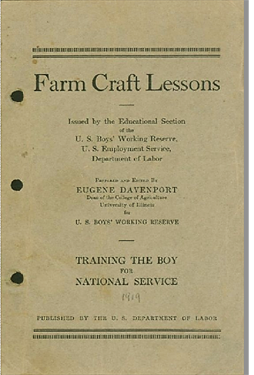
World War I created serious labor shortages in both agriculture and industry. Creation of the United States Boys Working Reserve was one solution to the shortage. The Boys Working Reserve was a joint program of the United States Department of Agriculture and the Department of Labor. Boys ages 16 to 18 were recruited for service mainly on farms; industrial and vocational units developed later. The boys worked during their vacation time or longer for a fair, predetermined wage. Typically, the wage was $1 a day plus food and lodging. If a boy could drive a tractor his wage was a little higher. One of the slogans of the Boys Working Reserve was “The Army Behind the Army.”
Many boys were drawn from non-farm backgrounds and training was necessary to equip them with basic farm knowledge. Schools were engaged in preparing the boys for service. Lesson books, such as this one, provided lessons focusing on the craftsmanship of farming rather than the scientific side. This guide provides illustrated practical lessons on grooming and care of farm horses, harnessing and hitching up farm horses, working farm horses, handling milk on the farm, separating and handling cream, working with swine, care of farm equipment, care of wagons, plows, mowers, gas engines, rope and its care, preparing seed beds, cultivating corn, shocking wheat and oats and market gardening.

